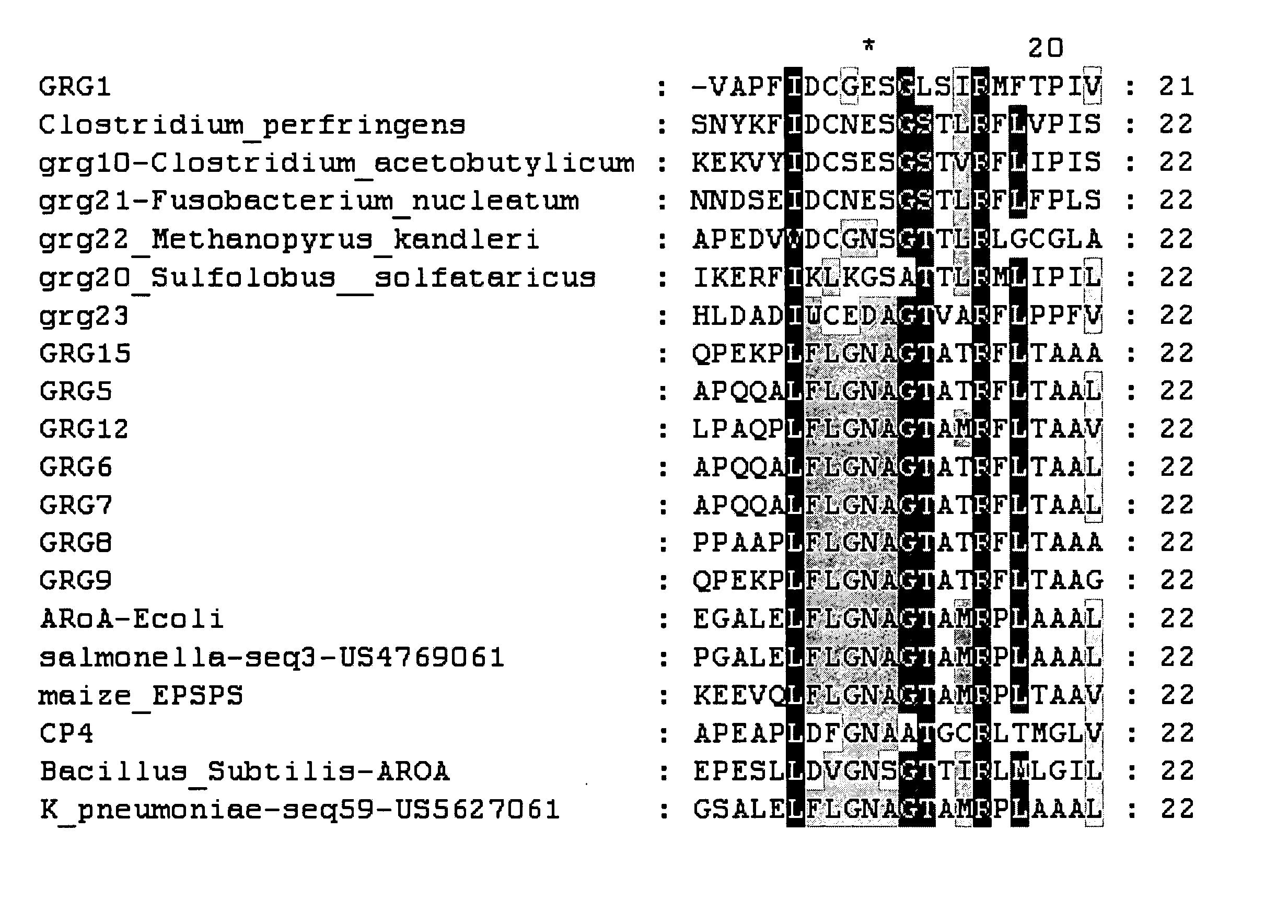EPSP synthase domains conferring glyphosate resistance
a synthase and glyphosate technology, applied in the field of plant molecular biology, can solve the problems of not only killing plant cells, but also toxic to bacterial cells, toxic to these bacteria, etc., and achieve the effect of increasing polarity
- Summary
- Abstract
- Description
- Claims
- Application Information
AI Technical Summary
Benefits of technology
Problems solved by technology
Method used
Image
Examples
example 1
Identification of Glyphosate Resistant EPSP Synthases
[0103] GRG1 is an EPSP synthase that confers glyphosate resistance upon both bacteria and plants. Comparison of the GRG1 amino acid sequence (SEQ ID NO:2) with the amino acid sequences of other glyphosate resistance EPSP synthase enzymes suggests that GRG1 is significantly different from these enzymes in the region corresponding to amino acids 90-105 of SEQ ID NO:2. This region is known to be involved in recognition of the substrate PEP (Schönbrunn et al. (2001) Proc. Natl. Acad. Sci. USA 90:1376-1380, Stauffer et al. (2001) Biochemistry 40:3951-3957). Notably, GRG1 has a motif of DCxES and a motif of PI in this region that are different from the other known glyphosate-resistant EPSP synthase enzymes. The DNA coding sequence (SEQ ID NO:1) and amino acid sequence of the grg1 open reading frame (SEQ ID NO:2) are provided in U.S. patent application Ser. No. 10 / 739,610, filed Dec. 18, 2003.
[0104] Alignment of GRG1 with other EPSP sy...
example 2
Glyphosate Resistance of EPSP Synthase with Homology to GRG1 in the “Q-Loop Region”
[0106] The coding sequence of the Clostridium acetobutylicum EPSP synthase gene (SEQ ID NO:5), identified in Genbank accession number NC—003030, was PCR amplified using the following primers: CAGGGATCCGCCATGAATTGTGTTAAAATAAATCCATG (upper) (SEQ ID NO:42) and CAGGGCGCGCCTTATTCCCCCAAACTCCACTC (lower) (SEQ ID NO:43). The upper primer changed the start codon to ATG from TTG, as it naturally occurs. The resultant 1.3 kb product was digested with BamH I and Asc I, and ligated into the same sites of a modified version of pUC 18 and transformed into the E. coli strain DH5a. A positive clone containing the EPSP synthase insert was identified by restriction digest and named pAX714. A pAX714 colony was struck onto minimal M63 media containing IPTG, carbenicillin and 0, 20, 50 or 100 mM glyphosate, and the plates were incubated at 37° C. The pAX714-containing cells grew very well on all concentrations of glyphosat...
example 3
Cloning the EPSP Synthase Gene from Sulfolobus solfataricus
[0107] The EPSP synthase coding sequence was PCR-amplified from genomic DNA of Sulfolobus solfataricus (ATCC 35092D and SEQ ID NO:11) using the following primers:
(SEQ ID NO:44)CAGGGATCCGCCATGATTGTAAAGATTTATCCATC (upper)and(SEQ ID NO:45)CAGGGCGCGCCGGTCTCATTCAATAGAAATCTTCGC (lower).
The upper primer changed the start codon to ATG from TTG to facilitate translation in E. coli. The resultant 1.3 kb PCR product was digested with BamH I and Asc I, ligated into modified pUC18 (pAX700 backbone) which had been digested with BamH I and Asc I, then transformed into DH5α cells. A positive clone containing the EPSP synthase insert was identified by restriction digest and DNA sequencing, and named pAX716. The encoded EPSP synthase was named grg20 (SEQ ID NO:12).
PUM
| Property | Measurement | Unit |
|---|---|---|
| temperature | aaaaa | aaaaa |
| temperature | aaaaa | aaaaa |
| pH | aaaaa | aaaaa |
Abstract
Description
Claims
Application Information
 Login to View More
Login to View More - R&D
- Intellectual Property
- Life Sciences
- Materials
- Tech Scout
- Unparalleled Data Quality
- Higher Quality Content
- 60% Fewer Hallucinations
Browse by: Latest US Patents, China's latest patents, Technical Efficacy Thesaurus, Application Domain, Technology Topic, Popular Technical Reports.
© 2025 PatSnap. All rights reserved.Legal|Privacy policy|Modern Slavery Act Transparency Statement|Sitemap|About US| Contact US: help@patsnap.com


